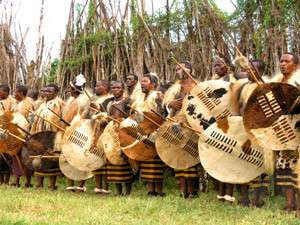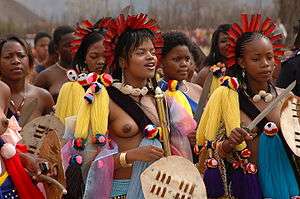Swazi people
 Swazi warriors at incwala | |
| Total population | |
|---|---|
| (2,482,046) | |
| Regions with significant populations | |
| 1,185,000 | |
| 1,297,046 | |
| Languages | |
| siSwati, English, Afrikaans | |
| Religion | |
| Christianity, African Traditional Religion | |
| Related ethnic groups | |
| Nguni, Sotho-Tswana, other Bantu peoples | |
| Swazi | |
|---|---|
| Person | liSwati |
| People | maSwati |
| Language | siSwati |
| Country | eSwatini |
The Swazi are a Bantu Nguni-speaking people in southeastern Africa, chiefly in Swaziland and South Africa. Besides their language, Siswati, they speak Afrikaans in South Africa and English in South Africa and Swaziland. There have been more Swazi people living in South Africa than in Swaziland since the late 1800s.[1] The Swazi people and the Kingdom of Swaziland today are named after Mswati II, who became king in 1839. Their royal lineage can be traced to a chief named Dlamini I; this is still the royal clan name. About three-quarters of the clan groups are Nguni; the remainder are Sotho and Tsonga descendants. These groups have intermarried freely. There are slight differences among Swazi groups, but Swazi identity extends to all those with allegiance to the twin monarchs Ingwenyama "the Lion" (the king) and Indlovukati "the She-Elephant" (the queen mother).
History
The Swazis are Nguni clans, who originated in South-east Africa in the fifteenth century, moved into southern Mozambique, and then into present-day Swaziland. The term bakaNgwane ("Ngwane's people") is still used as an alternative to emaSwati, to refer to the Swazi people. The Swazis are a Bantu-speaking people who are predominantly Nguni in language and culture. However some of the Swazi people originate from Sotho clans that were also inhabitants of Swaziland.
As part of the Nguni expansion southwards, the Swazis crossed the Limpopo River and settled in southern Tongaland (today in southern Mozambique near Maputo) in the late fifteenth century. The Ngwane people are recorded as having entered the present territory of Swaziland around the year 1600. Under the leadership of Dlamini III, settlement took place in 1750, along the Pongola River where it cuts through the Lubombo mountains. Later on, they moved into a region on the Pongola River, which was in close proximity to the Ndwandwe people.[2] Dlamini III's successor was Ngwane III, who is considered the first King of modern Swaziland. His rule occurred from around 1745 until 1780, and he ruled from the Shiselweni region of Swaziland.
In 1815, Sobhuza I became the king of Swaziland and was responsible for the establishment of Swazi power in central Swaziland. Here the Swazis continued the process of expansion by conquering numerous small Sotho and Nguni speaking tribes to build up a large composite state today called Swaziland. Sobhuza I's rule occurred during the umfecane wars, resulting from the expansion of the Zulu state under Shaka. Under Sobhuza's leadership, the Nguni and Sotho peoples as well as remnant San groups were integrated into the Swazi nation. It was during his rule that the present boundaries of Swaziland were fully under the rule of the Dlamini kings.
In the late 1830s, initial contact occurred with the Boers, who had defeated the Zulus at the Battle of Blood River, and were settling in the territory that would become the South African Republic. To establish a peaceful coexistence, a substantial portion of Swazi territory was ceded to the Transvaal Boers who were settled around the Lydenburg area in the 1840s. The territory of Swaziland, and their king, Mswati II, were recognized by both the Transvaal and by Britain. It was during the rule of Mswati II, that the Swazi nation was further unified and the people and their country became known as they are today. Thereafter, the label "Swazi" eventually was applied to all the peoples who gave allegiance to the Ingwenyama.[3]
Later under Mbandzeni, many commercial, land and mining concessions were granted to British and Boer settlers. This move led to further loss of land to the South African Republic. The result was that a substantial Swazi population was now resident outside Swaziland and in South Africa. The Pretoria Convention for the Settlement of the Transvaal in 1881 recognized the independence of Swaziland and defined its boundaries. The Ngwenyama was not a signatory, and the Swazi claim that their territory extends in all directions from the present state. Britain claimed authority over Swaziland in 1903, and independence was regained in 1968.
Today, Swazi people reside in both Swaziland and South Africa. People of Swazi descent in South Africa are typically identifiable by speaking SiSwati, or a dialect of the language. There are also many Swazi immigrants who go to South Africa for study, or work opportunities. The number of Swazis in South Africa is slight larger than that of Swazis in Swaziland, which is approximately 1.1 million people. In Swaziland, Swazi people include Swazi citizens regardless of ethnicity.
Identity
The Kings of Swaziland date back to some considerable time to when the Royal line of Dlamini lived in the vicinity of Delagoa Bay. The Swazi people as a nation were originally formed by 16 clans known as bemdzabuko ( "true Swazi" ) who accompanied the Dlamini kings in the early days. The 15 founding clans were Dlamini, Nhlabathi, Hlope, Kunene, Mabuza, Madvonsela, Mamba, Matsebula, Mdluli, Motsa, Ngwenya, Shongwe, Sukati, Tsabedze, Tfwala and Zwane. Other Swazi clans are the Emakhandzambili clans ("those found ahead", e.g. the Gamedze, Fakudze and Magagula), meaning that they were on the land prior to Dlamini immigration and conquest. The Emafikemuva ("those who came behind") who joined the kingdom later.
Culture

Dancing and singing, including praise-singing, are prominent in Swazi culture. Pottery and carving were minor arts. Swazi marriage is called "umtsimba", it is usually on a weekend in dry season (June - August). Bride and her relatives go to groom's homestead on Friday evening. Saturday morning - bridal party sit by nearby river, eat beast (goat/cow) offered by groom's family; afternoon - dance in the groom's homestead. Sunday morning - bride, with her female relatives, stabs ground with a spear in man's cattle kraal, later she is smeared with red ochre. The smearing is the high point of marriage - no woman can be smeared twice. Bride presents gifts to husband and his relatives.[4] Umhlanga is one of the well known cultural events in Swaziland held in August/September for young unmarried girls to pay homage to the Ndlovukati. Incwala is another Swazi cultural event held in December/January depending on the phases of the moon. This ceremony, also known as the "First Fruits" ceremony marks the King's tasting of the new harvest.[5]
Religion
The traditional Swazi religion recognizes a supreme God/creator, but more important are the spirits of ancestors. Swazi religion speaks of a creator known as Mvelincanti (he who was there from the beginning). However, Mvelincanti is too remote and so it is ancestral spirits emadloti is more relevant in day-to-day life.[6] Beasts are slaughtered and beer was brewed to please (propitiate) the spirits, and ask for help. The rituals are performed at the level of family associated with birth, death and marriage.[6] Some Swazis are also Christians.
See also
Umtsimba - marriage ceremony
References
- ↑ http://www.sahistory.org.za/places/swaziland
- ↑ http://www.swazi.com/sibiya/sdpeople.html
- ↑ http://www.everyculture.com/Sa-Th/Swaziland.html#ixzz2ev9N40UP
- ↑ http://www.sntc.org.sz/cultural/culture.asp
- ↑ Swaziland National Trust Commission. "CULTURAL RESOURCES: Swazi Culture The Incwala or Kingship Ceremony". Retrieved 22 November 2013.
- 1 2 Kasenene, Peter (1992). Religion in Swaziland. South Africa: ABC-CLIO. p. 384. ISBN 0313032254.
External links
| Wikimedia Commons has media related to Swazi. |
